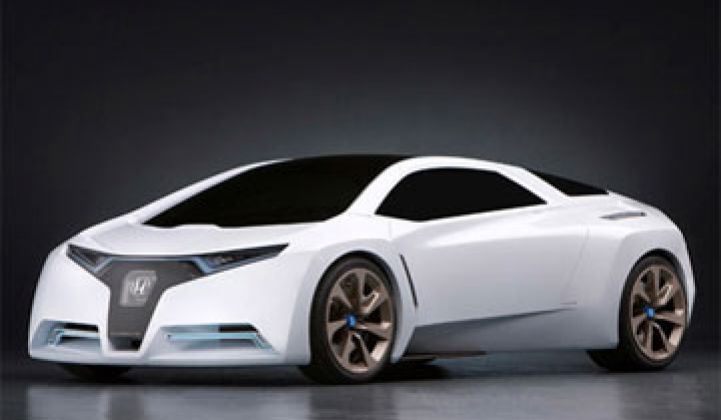This post is a contribution to Honda’s “Racing Against Time” thought leadership series. Greentech Media was selected to provide a unique perspective on how we should approach the discussion of oil as a finite energy source. During the first week of October 2010, five individuals will offer their own thoughts on the subject. These independent contributors were not compensated for their participation and as such their views are their own and do not necessarily reflect those of Honda. Details and links to what others are saying about “Racing Against Time” can be found at www.facebook.com/honda.
We can change the world. It will just take one test drive at a time.
Electric cars have returned from the dead in the last few years and so has the rancorous debate over whether they can ever adequately compete with gas and diesel vehicles.
Proponents claim that electrics and plug-in hybrids provide the sort of performance and capabilities that drivers will need for their daily requirements. With electrics, the U.S. and other parts of the world can also wean themselves from oil imports.
Critics counter that batteries cost too much and can't provide the kind of range that drivers require. To top it off, charging an electric car can take five hours or longer. Good luck getting the kids to stay patient during that pause in a family vacation.
The debate, though, often skips over a factor that I think tips the argument in favor of an electric future. Electric cars -- and motorcycles -- are a blast to drive. Fast, quiet and responsive, electric vehicles simply provide a new driving experience, particularly for drivers who've come to view their cars as draught horses for the daily slog to and from work.
With electrics, you often find yourself smiling because of the zippy sound of the engine or the surprise bit of acceleration that's available at top freeway speeds. And under the hood, it's spotless: there's not a grease stain or soon-to-fail mechanical part to be found.
Car manufacturers, I don't think, don't fully appreciate the opportunity here. These cars shouldn't be sold as symbols of compromise or hairshirt environmentalism. If the companies play their hand right, electrics could usher in the second coming of the muscle car era. Engine purists may sneer, but the mass of buyers will have more fun behind the wheel than they've had in years.
Even the small touches grab your attention. Many of the upcoming electrics don't have gear shifters. Instead, they have a push button transmission, just like the Batmobile.
And I'm not the only who's intrigued. Consumers really want to know what electrics are like. Recently, I test drove a mid-priced electric car in San Francisco. When I pulled to the curb, people began taking pictures. Strangers peppered me with questions. I felt like the Man of the Future: the only thing missing was the silver jumpsuit.
A group of British students are currently driving an all-electric sports car from Alaska to the tip of Argentina. "We've been stopped by cops fifteen times," team leader Alex Schey told me at the midpoint of their trip. "They just want to take pictures."
Scientific breakthroughs and the economics of volume manufacturing will help smooth out some of the looming barriers. A conventional mid-sized electric requires a battery that can hold 30 kilowatt hours of power. Back in 2007, lithium-ion batteries for cars cost around $1,000 per kilowatt hour
Now, some companies say that they are buying lithium-ion batteries now for delivery in 2012 for $400 a kilowatt hour, a 60 percent reduction in price. Lithium air batteries -- which potentially will hold ten times as much electricity as current batteries -- could be ready in a decade. IBM expects to have prototypes of lithium air batteries in two years.
Strong, lightweight composites will also allow auto makers to swap out steel. In electrics, less weight translates directly into longer driving distances.
Car makers will also have to educate and habituate consumers to some of the nuances. Neil Saiki, founder of Zero Motorcycles, said he had to add a safety bracelet to his all-electric bikes. Because the motorcycles are completely silent, owners would forget their bikes were on and occasionally lean on the throttle. Off the motorcycle would go. (I almost ran over Saiki on a test drive -- here's the video.)
Charging and range will also have to be explained. Complaints and horror stories about being stranded in a convenience store parking lot for hours will no doubt begin to emerge.
But deep down, the biggest driving factor will be psychology -- and consumer lust.
It's all a matter of handing over the keys.



